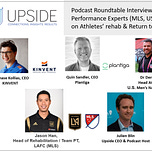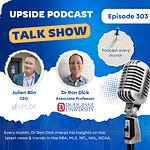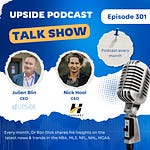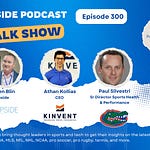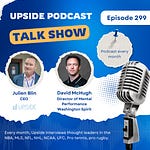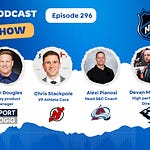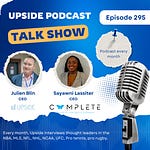This week we had the honor to interview again a group of sports performance experts.
Jason Han, Head of Rehabilitation / Team Physical Therapist., LAFC (MLS team).
Dr Derek Lawrance, Head Athletic Trainer, U.S. Men’s Soccer National Team.
Athanase Kollias, CEO of Kinvent, a company that helps sports and rehab professionals assess progress and build engagement and motivation.
Quin Sandler, CEO of Plantiga, a smart insole system for analyzing movement in the real world.
📝Show Notes: Through this interview, we touched on the current issues/challenges with the tools used for rehabilitation of athletes. Then we touched on the importance of the use of data as part of the rehabilitation process. Then we discussed the best practices that they identified when it comes to rehab/return to play of athletes. Lastly. we touched on the future of rehabilitation of athletes from a tech perspective.
🚀Best Quotes: Here are some of the key discussion points and best quotes from our conversation with Jason, Athanase, Quin and Derek:
On the key challenges for teams when it comes to rehab:
Jason Han:
“There are a lot of challenges. In addition to the tech, it will change based on the club and whether or not you're with the national team. This particular year, we’ve had a pretty congested schedule. This is a big challenge for us, as far as keeping athletes healthy and taking into consideration if you have a deep roster or not”.
“So when you integrate any kind of tech, it has to fit within the confines of how you do things and the time allotted for it. That's one of the biggest challenges. To add to that, I think objective testing is always a key component. But it also depends on the preseason, working with the performance staff and technical staff, whether or not they are okay with testing early on in the preseason. As rehab professionals, it's nice to have a baseline so you have something to compare to if they get hurt”.
Derek Lawrance:
“It really does depend on your settings, like Quin alluded to, and for someone like myself who's been in the club setting and now with the national team a bit, there are completely different challenges”.
“Ironically, we have more staff members with the national team, but we don't have the space to do it. And what I mean by that is we're constantly traveling. We don't have a training center. So in order to really get a job done when we're trying to do rehabilitation, it's what is going to give us the biggest bang for our buck and be mobile. So the biggest challenge in our setting is just space”.
“Going back to what Jason was saying is, time is in the essence and when you're going from game to game or if you don't have enough staff members to operate, and there's so much sports tech out there that you have to evaluate it pretty well and make sure that it's going to fit well within your system”.
“And are you going to get that return of investment on it? And I think that's another bigger challenge that a lot of practitioners see. You can get some great technologies, but how often are you actually going to use it? I am sure people who have these great devices may say you need to use it every single day and that would be great to do. but how easy can that be done? It is always going to be a challenge”.
Quin Sandler:
“I think hearing you talk Derek makes me think that there's such a disconnect sometimes between people that build the tech like myself and sometimes the people that use it. So I often hear time is the greatest thing that any practitioners have from trying to implement technology. And when I talk to groups about why some groups don't use this as much as others, and it always comes down to time”.
“A guy named Jesse Green that I've worked with a bunch at the Sacramento Kings (NBA) and the Penguins (NHL) where he talks about measuring at the terminal task. That is the most critical thing to do, and it is the most challenging to do”.
Athanase Kollias:
“As a CEO, I'm supposed to say that everything comes from data, but it's not what I think. What I really think is that the essence of return to play is to not have injuries at all. And this is where preparation is the most important thing. So the moment that we leave right now with the off-season is the most important one for the next season”.
“So for example Jason is going to have his athletes, and he is going to prepare them as much as he can, and this is the best way of not having injuries at all. So the essence of all it is to have them well prepared and then at the end it is also to manage their fatigue during the whole season”.
“So the only way sensors from Plantiga or KINVENT can help is by giving you some data to see if you are in the red zone or in the orange one”.
On the importance to build a trusted relationship with athletes in the rehab process:
Derek Lawrance:
“One other thing I think we're forgetting about in terms of issues is that it comes down to a relationship with an athlete as well, right? If you haven't built a stronger rapport with an athlete, or maybe you've had something happen in the past and now all of a sudden they may question you a little bit more”.
“But on the same side or the opposite side, you may have someone that just trusts you with everything and they're going to work hard and do everything you tell them and get some good results and that'd be great”.
“But it comes down to a relationship, and that personal touch just to get them to go over that threshold a little bit and trust that you're going to push them just enough to where they're going to be a little uncomfortable, but maybe not put them at risk. And that's always going to be a major challenge or an issue within the rehab setting”.
On the importance of the use of data as part of the rehabilitation process:
Quin Sandler:
“I wouldn't say it's the top of the pyramid, but it is very, very important. It's like data combining with kind of gut instinct and other intuition as well, but it is very, very important. I've been in situations personally where someone has been cleared and then we collect a bunch of data and they do not look like they're remotely close to go back, and that is a situation that I have seen a lot such as 30, 40 times”.
“And so what does that tell me? At least that tells me that that athlete was just about to go back to full on competition. And they are not remotely changing direction the same way, jumping the same way like they use to. And so those are situations where maybe data collection is on a little bit on the lighter side. So data is powerful”.
Athanase Kollias:
“In the end, it always comes down to a staff comprised of a physical therapist, a strength & conditioning coach, a coach, the manager, and then the athletes, and all of them have a different way of thinking things out”.
“So data can help by showing everyone where we are and hence making collegiate decisions. I will give you an example about the athletes. You have athletes that are competitors. Are they going to say that they are not ready? I don't think so. The athletes that I meet myself, for example in rugby, they may have an ACL, and two months after their injury they think that they can go back to play. But the data shows something else”.
Jason Han:
“Like you said, you're marrying that with the gut instinct. You're marrying it with your communication with the technical staff and performance staff. There's a saying in the medical world, that says “don't guess… assess.”.
“If someone's coming back from a hamstring injury. How strong is this person truly is if you're doing an eccentric hamstring test or an ISO? Then you can marry those findings with data on the field”.
“In a perfect world, we have a deep squad where we can take weeks to get this person back to speed. Rehabs where they are hitting everything on the field like they did prior to injury. Depending on how long they've been out of training, now they have to build enough of a base to get back to match play”.
“And like Derek says, with some players you have to coax along. You have to kind of push them and say no, it's okay. It's okay. And then it's not until they trust you that they'll go that speed. So it's very multifactorial but that's what makes it fascinating at the end of the day”.
Derek Lawrance:
“That's where some of the data can come in where, if you have baseline data in terms of the rehabilitation processes, being able to show the athlete, “here's where you were pre-injury. So now you've succeeded those numbers. So let's just take like an eccentric hamstring test or something like that. You had this previous score and this strength”.
“Now you've exceeded that. You've gone past it three, four weeks after an injury. This is why we believe that you can go a little bit further. And so using the data as part of the conversations, is massive. But we also have to remember that data isn't necessarily just always about numbers, even though the majority of the time it is. And what I mean by that is, Checking in with someone, how are you doing today? How's it feeling today? That's data”.
“And so people need to remember that. It's a little bit of piece of information that can go a long way. And so just understanding that these other points can be useful. And I would almost go back to what Quinn was saying earlier about. It may not be the most important piece, but it is a very, very important piece because of the other small pieces of data that you collect just through conversations”.
On the best practices when it comes to return to play:
Quin Sandler:
“I think Derek made the point earlier. If you can collect baseline data, it is so powerful. And if you don't have it, that's okay. There's still injury baseline, there's still baselines if you have no data on someone to see where they're or how they're progressing week over week”.
“But if you have good data for four or five sessions, that is just powerful because it is like “hey, we're going here, or at least as close to here as we can get. And so yeah I'm a firm believer in that”.
Jason Han:
“I'll second that to Quin. So let's say post-injury, you capture some data and you see an asymmetry and they may have had that asymmetry to begin with. So how much are we actually trying to change them at the end of the day?”.
“Having that baseline data is key and like I said in the preseason, they allowed us one or two days of preseason physicals, but at the same time, they want to train. So we have to make a decision of which tests to do so they don't fatigue too much because if they don't look good on the pitch, then the coach is going to be upset”.
Athanase Kollias:
“KINVENT comes from a world where 70%- 80% of our users are physical therapists with normal practices. And those guys never have the baseline, never. The customer arrives, he's already injured, so the baseline is not there”.
“So generally they will use the healthy limb as their baseline. So that's one thing. The other important thing is normalized data because they have data for normalized population in order to compare. The problem is that both those methods, as you said, they don't work on competition sports or pro athletes because the asymmetry may have been there already and general pop metrics don't apply to those”.
“So what is normalized data? What is normative data for a normal person, for athletes that are above all the rest? It is so true that those things that we use in normal physical therapy don't apply that simply. There's no population known with NBA players compared to me or you”.
Derek Lawrance:
“You probably have to start with the baseline, but also you have to come up with a proper plan and then understanding that you have to be vulnerable sometimes and know that your plan's just not going to work, and you have to go back and be willing to change it and adapt on the fly if need be, or learn from all the mistakes, right?”.
“And so the best practices for me is just cumulative experience from doing what you think is right and then has it worked, continue to do what has worked, and then if it doesn't, go back and refine it to make it work. Because at the end of the day, our goal is to get people back on the field and on the court and pitch”.
On the future of rehabilitation of athletes from a tech perspective:
Athanase Kollias:
“From what I see, I think that projecting a time to return to play is like projecting if an injury is going to happen. And I think that lots and lots of people have PhDs and masters, but I don't think that any one of them found really something that is capable of saying “this guy has a 95% chance of getting an ACL and then getting it”.
“So I think that we are a bit far from that. We can assume lots of things. Data can help in tracking it, but I don't know if we can really make very precise projections on when someone is going to return to play. I'm really sorry about that. I would love for us to be able to adopt those kinds of protocols, but it's a bit harsh”.
Derek Lawrance:
“From my early time in San Jose earthquakes and we were just getting started with GPS and now, there are GPS systems all over the place, so you just know that everything's getting refined, everything's getting better and better. And then obviously as more tech companies come out with their own algorithms or you know that the software that's going to be able to identify these risks in certain areas and also support us in different aspects of the rehabilitation”.
“I think that's the biggest thing for me and where sports technology is going to go. So if you don't know what the best situation in the future is, is to find one system that does everything for you without touching or putting anything on an athlete”.
Quin Sandler:
“I think, and again maybe because I live in the world of biomechanics, but what we've seen is I don't think we're going to be able to predict an injury. What I do think we're going to be able to do is say, Hey look, this is how biomechanics, whether through IMUs or optical tracking, this is literally how the limbs move roughly around three or four months post-op AC”.
“This is five or six, this is seven or eight, this is nine or 10. And what I think is going to happen is more like, Hey, by the way that you're moving with patterns, you're a little behind where most people are at this”.
“So I don't think it's going to predict it, but I think we're going to be able to have a lot of aggregate data on different orthopedic sports subtype injuries like Achilles and, and then I think as those data sets go of how these movement patterns go, we'll be able to tie better lines to where people are and then how they're progressing themselves. So I don't think it's a prediction, but I think it's going to be a better understanding”.
Jason Han:
“GPS works because it's live data. It's just going after the fact, you can clip what you need. So with most motion analysis systems, you have to do one movement at a time. But then that takes set up and time”.
“So if we can make a complete system, ideally that they're on the pitch and you can decide which movement you are going to break down, but I'm not a tech guy. I don't know if that can be done, but that would be amazing”.
“For example, if you were to look at a match, we know high speed running, access, decals, all this kind of stuff. But if you knew the movement data. How many times did they cut off the right, how many times did they cut off the left? What were hip angles?”.
You may also like:
🔥 Upside Chat: Dave Hancock, CEO, Apollo (Leading Athlete Management Systems (AMS) vendor)
🔥 Upside Chat: Dr Andy Barr, Consultant, Brooklyn Nets (NBA) & Quantum Performance Founder
🔥 Upside Chat: Ismael Fernandez, ThermoHuman CEO
🔥Upside: AMS Ecosystem Analysis: Key Trends, Vendors and Recommendations to Teams
💦Upside Analysis: The sweat and heat sensing market (Key Trends, Vendors)

